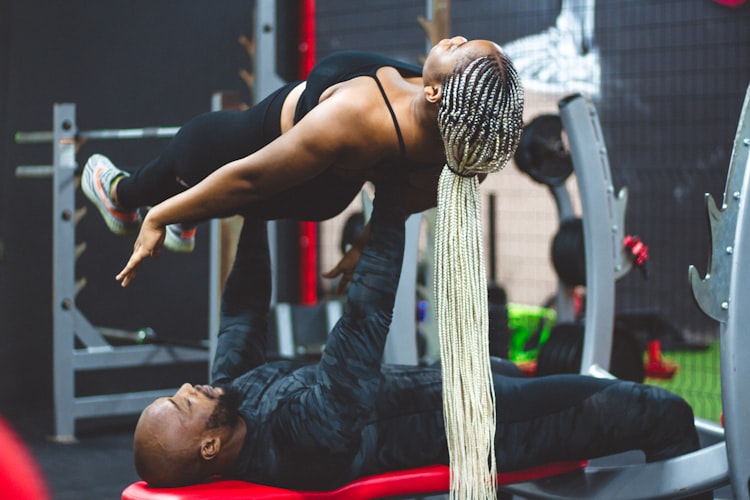The X Split Routine

The X split follows the K.I.S.S. principle, and not in the keep-it-simple-stupid, kind of method, but more so the keep-it-short-and-sweet method.
Arguably most people don’t want to spend a ton of time in the gym and the X split can help make that a reality.
When they are there, they should spend time perfecting the basics and when possible I generally favour full body training for the most part because it’s easy to scale into a week, maximizes frequency, and improves consistency.
The body works as a whole, so it makes sense to train it as such. Sixty years ago, most bodybuilders would have used a full body approach, long before steroids became the standard assistance method of frankenstein routines and the “no pain, no gain,” mentality began ruling gym culture.
Full body training is also the most easy approach to adjust to work schedules, life hiccups, and opens up other days for you to do other stuff; that could be interval training, or aerobic training or just getting out for a walk and spending time with your kids.
Why train more that 3 hours a week really if you don’t have to?
Well sometimes you want to, sometimes you have to, and sometimes you’ve got the time to.
Unfortunately some people don’t or can’t always train Monday/Wednesday/Friday, or Tuesday/Thursday/Saturday to utilize a complete full body training method.
Full body resistance training typically requires a day off between bouts for recovery reasons, at least for us mere mortals*.
*You can cycle full body training more frequently in certain circumstances, like in highly trained athletes, or even bodybuilding, if you know what you’re doing, but that’s the topic of another article.
It takes longer for the body to recover from intense forms of neurological training than it does from lower intensity forms of training like aerobic training.
Yes, adding training time can be a way to bolster results.
However if you’re like some of my clients, you only have time Tuesday/Thursday/Friday or Saturday/Sunday/Wednesday.
Sometimes you have to get a little creative.
Most people have more time to train on weekends, though I’m personally guilty of being far lazier those days, so it often makes sense to put the bulk of training time on days you have time.
So what can you easily do when you have train back to back days? Especially if you want to use paired sets? As in 2×2 training?…
Enter the X Split
I’ve never seen anyone use this approach before (and there might be good reason for that…), so if I’m innovative about anything in life this might be that one thing.
The X split is a simplistic representation of training movements characteristic to certain areas of the body, that I was for a long time painfully calling the LA-UP/LP-UA split.
Explained below …
Abbreviations of the anatomical locations of what you’re training:
LA = Lower Anterior
UP = Upper Posterior
LP = Lower Posterior
UA = Upper Anterior
Upper = above the trunk
Lower = below the trunk
Anterior = the front of the body
Posterior = the back of the body
As you can see the approach looks like an X when you look at the body from the side:
Day 1
- Knee or Quad Dominant Moves (Anterior Lower Body)
- Upper Body Pulling Moves (Posterior Upper Body)
Day 2
- Hip or Glute/Hamstring Dominant Moves (Posterior Lower Body)
- Upper Body Pushing Moves (Anterior Upper Body)
This is a far cry from traditional — and somewhat wacky — bodybuilding splits that view things in terms of muscles.
Honestly, I rarely rarely use bodypart splits anymore even for hypertrophy programs…
It’s also very different from a traditional upper/lower (UL) split, which I’m not saying isn’t effective.
I also use an UL split from time to time, and it is effective (particularly for things like powerlifting and training for strength), it’s just not always the best option:
- UL splits tend to beat up very specific parts of the body so especially your legs are in rough shape for days (more problematic if you have other active stuff you want to do)
- This was especially true when using more muscle building phases of training, with moderate intensity and moderate reps, less so with lower volume strength specific programs
- It’s harder to use paired sets with UP splits, though mostly in the lower body
- UL splits don’t seem to be as applicable for body composition (fat loss) objectives
- UL splits limit the connected movements you can do between the upper and lower body (for example olympic lifting — though I know a lot of coaches just put them on lower body days…)
I started experimenting with this in 2009, when I first utilized it with the University of British Columbia’s (UBC) Football team.
The head coach at the time was adamant that the program feature olympic lifting, particularly the clean — for those that don’t know, the power clean is a staple American Football exercise — and he wanted his athletes, particularly in the off-season doing weight training 4x a week and he was looking for some increased size.
Now…
I’m a professional, so naturally I gave the coach what he wanted.
In all likelihood some additional volume would help these guys put on a little more mass and HRV systems weren’t as accessible as they are today to more closely monitor training stress…
You don’t have to train 4x a week, you don’t have to do olympic lifting and you don’t have to focus a ton on size for this program to be effective.
I’m generally a 3x a week resistance training guy; I’m generally a let’s-focus-on-strength-and-power that can be expressed on the field over non-functional hypertrophy kind-of-guy; But when you are given lemons, you make lemonade.
If I can overcome my bias’ in training, so can you!
I like olympic lifting, but usually only with athletes, usually younger demographics and I think it’s easier to program with full body training…
The reason being it already requires such a huge amount of muscle, with the only muscles not being used in the front torso part of the body.
I was also training 85 athletes out of 2 visitor locker rooms in the bottom of Thunderbird stadium from 6-9 in the morning, long before they had a proper varsity training facility.
Sounds worse than it is, I actually had a ton of fun…
Mostly because of the constraints placed upon me, it forced me to get creative.
Note: If you’re ever having a block about work, give yourself a constraint, it will immediately bring out the best in you.
I started with a UL split, with Olympic Lifting on the lower body day but very quickly I was getting complaints about being too sore or that guys were having terrible upper body days after olympic lifting the day before.
So I went with an Olympic Lift, paired with some horizontal pressing on Day 1. Different Olympic Lift on Day 3 with some vertical pressing.
Hip oriented moves like power cleans, power snatches, etc… and press oriented moves.
Gave me an option to use a paired set after the olympic lifting by pairing a non-explosive hip dominant move with the pressing.
That might look like something like this:
A) O-Lift (3-5 reps)
B1) Deadlift (4-6 reps)
B2) Bench Press (4-6 reps)
C1) Single Leg Bridge or Hip Hinge (6-12 reps)
C2) Incline Dumbbell Press or Cable Press (6-12 reps)
Then any accessory or isolation work we occasionally had time for following the same principles…
Now there is some upper body pulling action in the deadlift and the o-lift.
However, what makes people sore from o-lifting in the back muscles, is typically dropping the weight back to their waist without dropping it.
So first, we encouraged everyone to drop the weight. Not something everyone can do in every gym, but we had lifting platforms and bumper plates, so we could.
Next, we mixed up the rep ranges typically using higher repetitions on Day 2, then we took the next day off.
Day 2 would often look something like:
A) Squat (8 reps or so)
B1) Lunge (8-12 reps)
B2) Chin Up (Max reps typically put people in a 6-12 rep range)
C1) Step Up (10-12 reps)
C2) Face-pull or Row (10-12 reps)
Again any accessory work we occasionally had time for following the same principles…
So you’d see any arm curls or flexion based arm exercises, some additional core work, or possibly some calf work on Day 2.
Any extension based arm exercises, grip work or carries could fall on Day 1.
Typically we’d have more time for accessory work on Day 2 because the rest required for o-lifting is typically greater.
Anyhoo, that’s how it all came together and by the end of the next 4 weeks, I had less really sore athletes, some good results and some good insights:
- I could scale back the o-lifting to the 2 X split days, and then do 2 UL days and still get a 4 day split for the next phase (then alternate)
- It gave me a better variety options (particularly using a clean and jerk, or a land-mine clean and jerk, or a more connected movements like that)
- Utilizing a different split alone, probably stimulated athletes in a different way, and that change itself probably led to a better initial training outcome (it got less and less so the more I used it)
- The X split made surprisingly better sense for recovery probably because it took some of the volume off specific body parts on each day (you get twice the volume on the legs day with a UL split typically)
- Coach didn’t know the change I had made, but told me several times that practices went better (could be placebo, could be confirmation bias on my part, I can’t say for certain)
- The X split made even more sense when in season. They play Saturday, get Sunday off. Come back Monday/Tuesday on an X split, get Wednesday off, then do a full body lighter day on Thursday, get Friday off before the game.
It lead to a bunch of other ideas but I won’t get into all of that, how I use the X split now with your everyday client that has to train on back to back days is probably a lot more useful to you.
Using the X Split
Now assuming you’re not a football player, and you’re a fan of the paired set style of training I introduced in the 2×2 Training Framework, your program should look a little bit different.
What you see above probably sounds complicated but what it resulted in is actually quite simple.
In the 2×2 training framework I discussed the concept of paired sets, and for 2×2 training you use 2 paired sets of exercises for a total of only 4 exercises.
That idea can easily extend to the X Split Routine it just gets spaced out differently.
Day 1 (LA/UP)
A1) Bilateral Knee/Quad Dominant Lift (Probably a Squat…)
A2) Vertical Pull (Chin Up Variation)
B1) Unilateral Knee/Quad Dominant Lift (Probably a Lunge or Step Up…)
B2) Horizontal Pull (Row Variation)
Day 2 (LP/UA)
A1) Bilateral Hip/Glute Dominant Lift (Probably a Deadlift…)
A2) Horizontal Push (Bench/Push Up Variation)
B1) Unilateral Hip/Glute Dominant Lift (Probably a Loaded Glute Bridge or Single Leg Deadlift)
B2) Vertical Push (Incline Bench or Overhead Press Variation)
Honestly, from there you can add accessory movement after the fact if you think you need it. Most people will need a little something, something, but this is a great starting point for most folks.
The other nice thing is that you can often get through this in 20-30 minutes, not including your warm up.
Anyway, give that a try if you can’t train full body and let me know how it goes in the comments.




